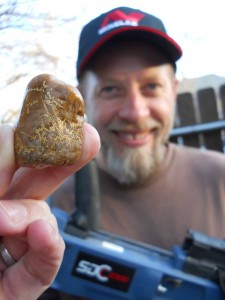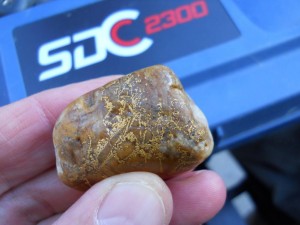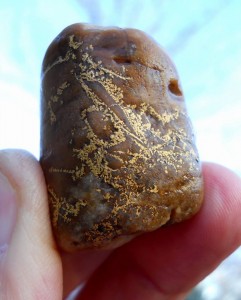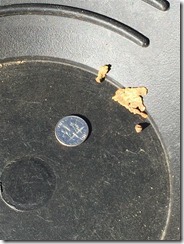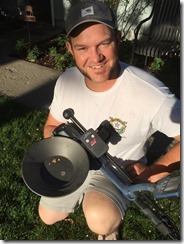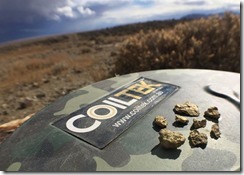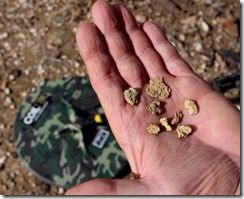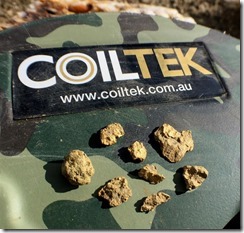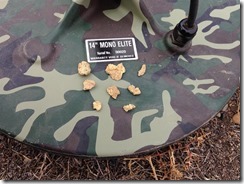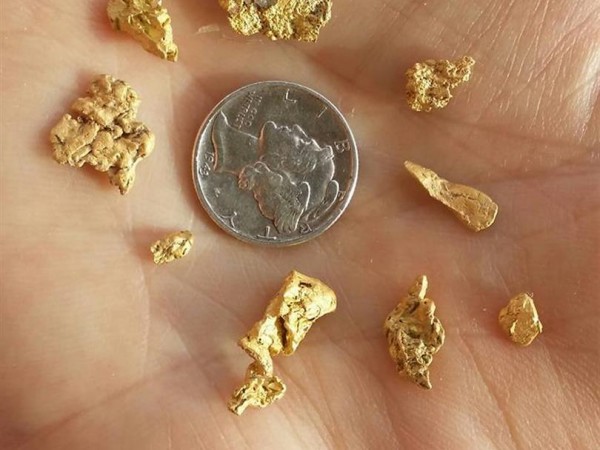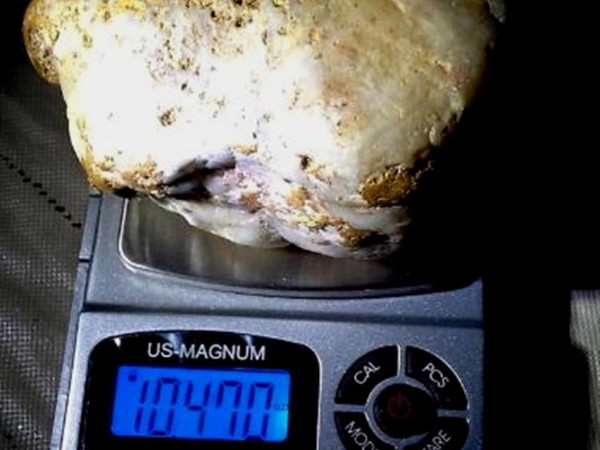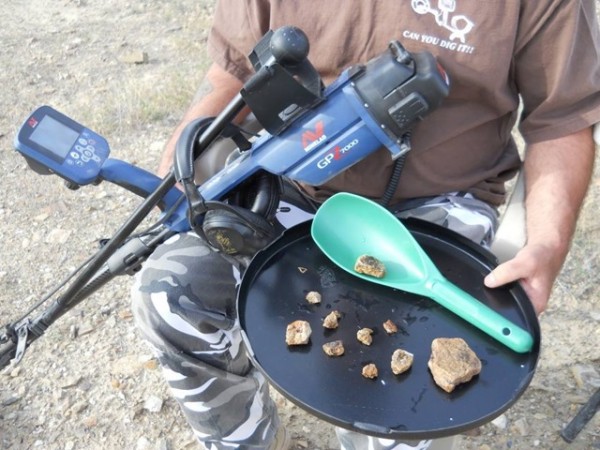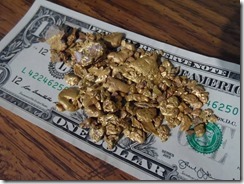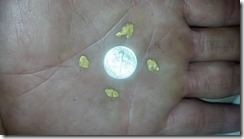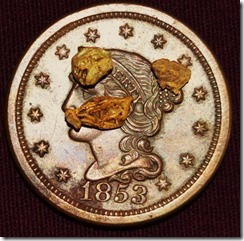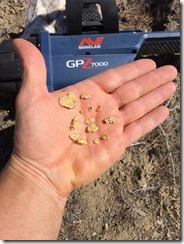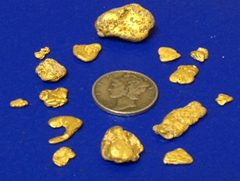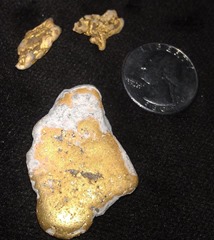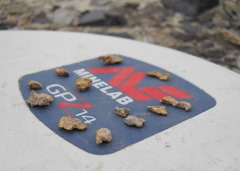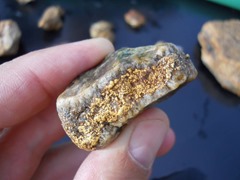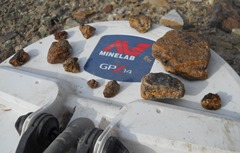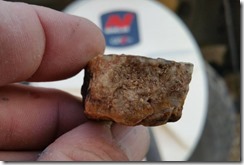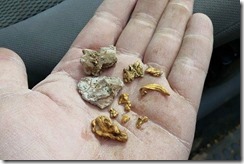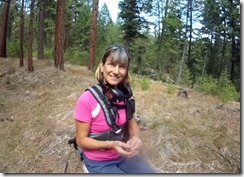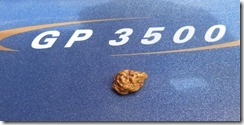CTX 3030 and XP Deus comparison from a Ghost Town laden with iron and a Gold Coin found by the author.
July 11th, 2018
Cody Holmes
I was fortunate enough this spring to obtain permission to hunt a private property Ghost Town. The area is very close to my home so for me it was very exciting not having to travel but a few minutes to my new site. I wasn’t however, ready for what was to become one of the most difficult sites that I have ever detected. I arrived all excited to find some old coins even though I knew the site has been detected by many others. The site is around 150 years old and has been a Ghost town for 100 years more or less. It wasn’t a large town but the buildings covered a very large area since it was more of a farming community.
Now to get to the site and the problems I faced. I grabbed my CTX 3030 with the standard coil as I usually do, turned it on did my adjustments. The area is now plowed fields with no building sites or pictures that I could find at all. The only way I could figure out where things and people were was to look for iron and or glass. So I removed my discrimination pattern from the CTX and ran an open screen, so I could hear the iron in hopes of finding good areas like buildings. That was really funny. There was so much iron the CTX sounded like a machine gun. I didn’t want to change to the 6-inch coil because of the plowed furrows and the enormous size of the area. I figured I was in a bad spot and would try to listen to the machine on the fast setting, go-slow and try to work between the constant sound of iron targets. I did that for a bit and finally changed to one of my custom programs with some Disc. I was finding a few non-ferrous amongst the iron so off I went. What I was finding out was the CTX was falsing a lot on the furrows as I went over them, so I had to work them as much as possible. I thought about changing to small coil but because I was trying to get the best depth I could I held out.
A couple of hours later being somewhat disappointed I decided to try a new plan. I had recently received an Elliptical HF coil from Gerry and thought this would be an ideal spot to see how it would handle this junk yard. I went and got the Deus setup with my own program I run for coin hunting and went to swinging. Now the Deus runs a faster recovery speed than the CTX so it should be better at this task. Now, with the faster recovery speed you will lose some depth but it will also see targets the CTX won’t. I started out with the HF coil on 28 setting thinking it would be more sensitive on smaller targets. I was right it was. It loves finding small bits of iron and telling me it was a good target. Time to change things. I went to the 14 setting and made some other tweaks and got the XP running very quiet in this bad iron. So you know you can look forever to try to find a clean spot to ground balance your coil and you will not find one with an 11-inch coil, I tried. After hunting a while longer I did some more adjusting on the silencer and reactivity to make the machine work as I wanted. I need you to understand I hunted this site for about 3 months and worked with both machines trying to refine them to suit this site.
Now to sum up what I learned about the two machines. The CTX as I knew would found some deep targets that the Deus missed. To that I had to go so slow and do the Minelab wiggle on every half-way good sounding target. To say the least it was difficult but also paid off in some very nice tokens. What I didn’t like was the amount of square head nails that it found and because of the site I had to dig. It did do a pretty good job on the rest of the iron including the most big iron. The round harness items were dug all the time sounding like bigger silver, that is to be expected. All in all the CTX did a good job at what it is designed to do as long as I used very little discrimination so it would not blank out over large areas.
The XP Deus as it turned out was my detector of choice for covering the area and then I would follow up with the CTX. I found the only way to be successful was to grid a smaller area then go back and use a circle search pattern to come at the targets from all directions trying find a non-ferrous item. I was and am very happy with the Deus in this iron. I know I have not found all the targets, it is impossible. I did however find my second GOLD one dollar coin with the Deus using the new coil. I was able to get machine run smooth and could get around 6 inch depth on a dime but again without my knowledge from the CTX on how to wiggle out some targets it too would not have found some really good items. The shape of the XP Elliptical coil was a huge deal. The round coils could not see or sort out some targets. I did take the time to do a lot of testing.
Pictures of most of my finds with the machines are on my Facebook page: https://www.facebook.com/RyePatchRon. I need both of my machines to work this area. Is one better than the other yes, at certain task but without having both and knowing how to adjust them most people would have gone home after a short time of digging iron or no non-ferrous targets. You have to put in the time to learn your machine and what it will or won’t do. If you think mine is the best and don’t miss anything you would be wrong on a lot of sites. Yes some sites you might get most of the targets but no one or one machine will get them all. I know for a fact these guys would still be in the dirt if not the XP Deus and the New Elliptical coil. 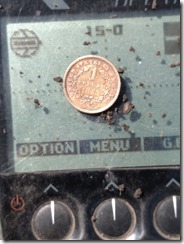 Thanks to Gerry at https://gerrysdetectors.com/ for getting one in hands as soon as they were available. The gold coin and the tokens has paid for the Deus on this one site alone.
Thanks to Gerry at https://gerrysdetectors.com/ for getting one in hands as soon as they were available. The gold coin and the tokens has paid for the Deus on this one site alone. 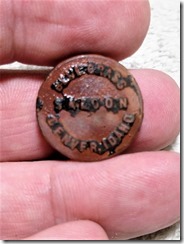
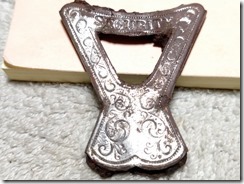
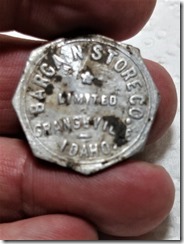
My first impression from doing limited testing on the new HF 81 khz coil are positive to a point. I have not completed all the testing that needs to be done. This trip I hunted for a certain type of gold in tailing piles so not all types of conditions for nugget hunting were met on this hunt. When hunting tailings I encounter iron, trash of all sorts and non ferrous unwanted targets ( Aluminum beer and pop cans). People just won’t take their trash with them. PICK IT UP PEOPLE!!!
I have been working on creating a program with the 9″ standard coil but was not happy with the results. It worked out great getting rid of unwanted targets both trash and unwanted non ferrous targets. The problem I encountered was it would not see some small gold. So when XP Deus announced the new HF coils I was excited at the possibilities. I was apprehensive though since I have been around nugget hunting with different machines and technology everything needs testing to prove it in your areas.
With the 80.8 HF being the highest frequency that I have used over a piece of gold I was hoping for the good things to happen. I have used the Fisher Gold Bug 2 for years and it’s 71 khz is a killer on gold and especially small gold.
What I was looking for with the XP Deus was being able to discriminate out unwanted targets and still finding small gold in specimen pieces as well as big gold of course. From my experience with the Deus I knew it really likes hot rocks, it will sound off on them like a pop can. In the area I was hunting there are 3 different frequency”s of hot rocks. With the lower frequency coil I was able to notch or discriminate them. With the HF coil that was not happening.
I had to come up with a new plan. I tried to ground balancing over them but with different kinds that was a no go. The answer go to – tracking mode in the ground balance. It worked perfectly, the hot rocks were gone immediately.
Now I know that using tracking can cause other issues. For instance you can track out a good target with some machines. You also will lose depth. Manual ground balance is always better for getting the most out of your machine. I had to use what worked for my needs in this area. Tracking was that choice. I now had to test out how much sensitivity and depth I was losing. I placed different types and pieces of gold on the area and ON the hot rocks to see if this would work for me.
Here is an example of the gold I tested.
Small vial of loose little pieces. Bug 2 1/2″ XP 3 1/2″ — 2″ on hot rock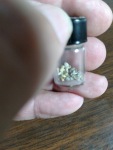
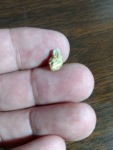
1.3 gram nugget Bug 3 1/2″ XP 5″ — 3″ on hot rock
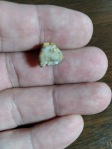
3.8 gram specimen Bug 4 1/2″
XP 6″ — 4″ on hot rock
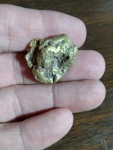
29.7 gram solid nugget Bug 7″ XP 11″ — 8″ on hot rock
Large specimen piece containing very little salt and pepper gold. Bug 1″ XP 2″ — 1″ on hot rock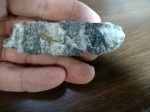
I did lose depth but it was not enough to bother me. When hunting for this type of gold you are looking for larger pieces but will be happy with the little ones as well. Depth is not the biggest concern because digging in rock piles at depth is not productive. There are way too many big chunks of iron found after digging forever with all the rocks falling in your hole. For me in this type of gold hunting is 6 to 8 inches of depth and cover ground is the choice.
I did try the gold only program but it was not the way for me. Now out in clean ground it might be the way to go. When I get a chance to give that a go I will but that was not my goal for this trip.
I used a modified 2 tone coin program to get the XP to perform with the HF coil. I was not able to discriminate out all non ferrous targets like I hoped. The reason being the HF coil reads gold from just over 30 to high 90’s on the ID meter. Both type and size of gold makes a difference. In order to dig only the better targets and to identify big iron I also set up my coin program on 14 khz in the next slot to check some of the targets I encountered. It makes things more efficient and wastes less time. The more targets you get over and check the better your odds of hitting the GOLD.
Your results may vary.
Rye Patch Ron
MY opinion on the Deus 4.0.
By Rye Patch Ron
First off before I get into settings let me say this. There are NO settings for this or any other machine that are perfect for all sites like some people lead you to believe. You can achieve reasonably close to the same end results in different ways, these are mine.
Let me clear up one thing that I don’t think most people know about the Deus. ALL of the programs can be made to do the exact same thing with the exception of the Gold Program. The preset programs are just a quick way to choose one that is ready to go without any modifications. Some of them are ok for a lot of situations and for someone that doesn’t like to tweak things a bit but maybe not quite as good as they could be for your site. Now for the beginner there is not a thing wrong with one like Basic, GM Power or G-Maxx. They are all good programs and in some spots are very good. I have changed on how I run the 4.0 from the 3.2. I no longer worry about about iron wrap around. As far as I see there is no need but IF you choose to notch out the 98-99 iron numbers MAKE SURE YOU DO NOT GO ABOVE 98 ON YOUR NOTCH. The 97 number will disc out some half dollars and all Silver Dollars.
Let’s do some looking at the Deus menu to hopefully help you understand what each option does or can do. Now remember this is my opinion for the ground, trash and USA coins. The reason I mention this in different countries the soil and the targets that are being searched for is way different.
Discrimination: This setting does just that, it can and will remove SOME unwanted targets. I set it accordingly to the site and what I don’t want to find. This is not hard to figure out, if you don’t want to hear a square nail run the disc up to the number it takes to get rid of it. That usually is somewhere at 6.0 or more. Disc can be run as high as you need. It can depend on which Khz you are using.
Sensitivity: I set this one one of two ways. If the site is full on iron and I mean a lot not just some here and there. I will turn it down to in the mid 80’s. The reason for that is simple if the iron is real bad and it sounds like a machine gun when you swing your coil you are not going to get maximum depth. Also the higher the setting the more likely you are going to be picking up multiple targets and not be able to sort out the good ones. The Second way I set it is for a good spot where there is little or average iron in the ground. In this case I will turn up the sensitivity until it starts to chatter and become unstable then back it off 1 or 2 numbers.
Frequency: Now here is an ambiguous choice. The higher the setting 17 vs 4 is entirely up to you. At 17 you have a better possibility to find fine gold chains and small coins. At 4 khz you are unlikely to even hear a small gold chain. So it depends on if you want to find gold chains then 17 khz is the choice but you will lose some depth on deep coins. 8 or 4 is better for most coins except dimes. Also the 8 khz and 4 khz are not as sensitive to tiny bits of iron. I use 8 and 12 most of the time for coin hunting.
Iron level: This is a setting if you want to hear the iron targets. It sometimes helps to be able to listen to the iron and try to pick out a good target that might blend in with the iron if level it is set to 0. A setting of 2 or 3 will work fine to hear non ferrous next to ferrous targets in this instance. Now if the iron like I mentioned before is horrible then I will choose to run it at 0. I use the 2 or 3 setting if I am yard hunting in average conditions. Again your choice of what you want to hear or how quiet you would like your machine to run.
Reactivity: This setting is a big one! It sets the speed your machine will process what it hears. At 0 it still processes faster than most machines that are on the market. So you have to use your head and think here. Is the area you are searching fairly clear of iron and trashy stuff like aluminum? If so set it low for better depth. The lower the reactivity the deeper your machine can hear. If you have a lot of iron 3 or 4 but you will loose depth big time but allow you to help separate targets . As you get better with your machine you can run it lower and compensate by slowing down, listening and rechecking any higher pitch to see if it was a good target. If you just swing along and do not constantly recheck the maybe’s you will miss both deep and good targets.
Audio: This is just that volume of the signal. For me the higher it gets the more distorted it sounds and I use headphones most of time so 3 or 4 is fine. If you are not using them then you might need to run it higher. It does not increase the signal just the volume. It is not an amplifier.
Notch: Notch is used to discriminate out a single or group of numbers. For a group just select the notch from the main menu. If you want just one or two numbers then select the expert menu and blacken your choice. Most of time I don’t use a notch because of what other targets I might lose. Say you chose to blank out pull tabs. Then say goodbye to some rings. Again your choice.
Ground: You have several choices from manual to tracking. Tracking uses more of the machine’s resources to constantly check the ground and adjust. I use manual myself but you do need listen and watch your machine, adjust as necessary.
Think of the Reactivity and Silencer as filters because that is exactly what they are. The higher they are set the more filtering they do. The Reactivity filters iron and minerals in the ground. The Silencer filters EMI and some ground noise.
These are my settings that I START with and adjust as necessary.
For an iron infested site: I used program #6 with the XY option to help see the larger iron targets that will give you GOOD ID numbers from 90 to 97. You have to use your head and eyes here. If the big chunk of iron is deep it will sound good but the lines can be all over the place. Those are easy. If the lines are close and saying dig me then lift your coin up. If you can still hear the target 6″ plus off the ground then most likely you are over big iron. As for small iron that is what the discrimination settings is for.
Disc to 8
Expert mode 5 tones. Breakpoints and tones: 202-8 351-45 450-65 651-89 800 hears the silver. These are my choices they are your choice on both tone and breakpoints.
Sens: 87 TX power 1
Frequency: 12 khz
Iron Vol: 0
Reactivity: 1 Silencer 3
Audio: 3
For your average yard hunting:
Disc. 6.0 or up depends on nails.
5 Tones as above.
Sens: 92+ set till chatter then back off. TX power 3
Frequency: 8 khz
Iron Vol: 2
Reactivity: 0 Silencer -1
Audio 4
Ok people that is how I run my XP DEUS 4.0
Good Morning,
If Lunk hasn’t told you yet, I had a wee bit of a problem with the Cholla, (still digging the needles out) and the harness….I’ll figure a way to better deal with both. Now to the assessment I promised, I like to put together a basic legend with a grading scale…the higher the number the better the rating. I think this provides a better assessment than just he did this or that etc.
GPZ knowledge of the product….8 … (Not higher because I don’t know the machine well enough to determine if he was lacking anywhere). He certainly knows more about the machine than I do and I learned from him.
Attitude: 9… I don’t give out 10’s….so this is a high very grade for me….from the beginning he was professional and easy to deal with. Very important when you first meet someone…a great first impression goes a long way in my opinion.
Communication: Listening and sharing…..Both 9’s…. This is where he scored better than anyone I’ve worked with before. I had been trained by 5 individuals (various machines) before Lunk in the 20 + years I’ve been in the field…..so this wasn’t new for me… he was patient and answered every question I posed…
Personality: 9… Pleasant disposition, he made feel like I could ask anything at any time and he was very attentive to my needs as a trainee with the 7000.
Follow-Thru…9… This is usually an area I give low scores for…..but Lunk has already followed through with web links etc. as he promised that he would.
I have no particular reason to grade Lunk so high, I gave him what I thought he genuinely earned. I’d try and hang on to him Gerry.
-Will
Let me introduce myself, my name is Kendall. I have now completed two separate classes that Gerry McMullen includes with the purchase of gold nugget machines. In my case it was a Minelab GPZ 7000 and the SDC 2300.
Thanks goes to Gerry and his staff for the hands on training and helping me to understand how the pros set up their detectors and explaining why and how to do it their way. The confidence you gain is priceless when you are all alone in the field and that self doubt starts to creeps into your thoughts.
The class is structured so that if anyone hits a target we all gather around and learn first hand all the possibilities and get to hear what your detector sounds like. The majority of the class did find nuggets.
One day was dedicated to a class setting and we all got to learn from Gerry’s 35+ years of experience and the wisdom he has gained over the years. Gerry displayed a variety of recovered gold in different shapes and sizes in it’s natural form, while demonstrating the abilities between each detector model. These comparisons helped build on that confidence factor of which detectors perform best on different kinds of gold. The kinds and types of gold was beyond description.
The neat part of my story is the fact that only after 45 minutes of detecting I found a nugget that weighed 1.9 grams. Apparently it is a special form of gold nugget called a chevron. 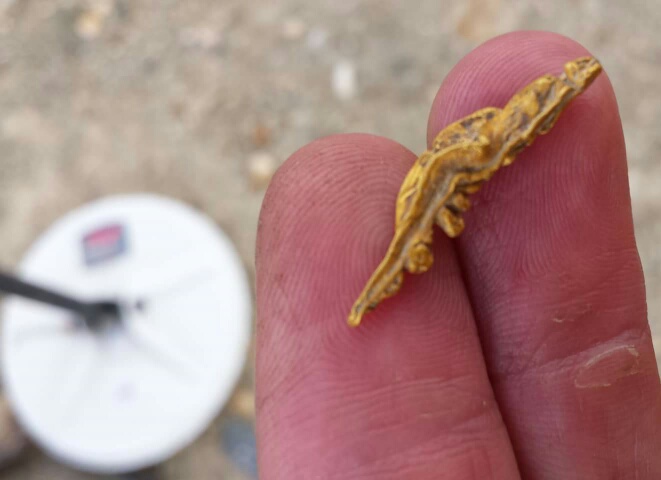 I was told they are not common and I may never find another one that unique. I was fortunate that no one was recording because the celebratory dance would be very embarrassing.
I was told they are not common and I may never find another one that unique. I was fortunate that no one was recording because the celebratory dance would be very embarrassing.
I would recommend Gerry’s class to anyone wanting to increase their confidence and ability to recognize and learn the capabilities their gold machines.
In closing, we were asked to tell everyone what our best find was…..you might think it would be that nugget but actually it is Gerry McMullen and all that he has shared during the classes.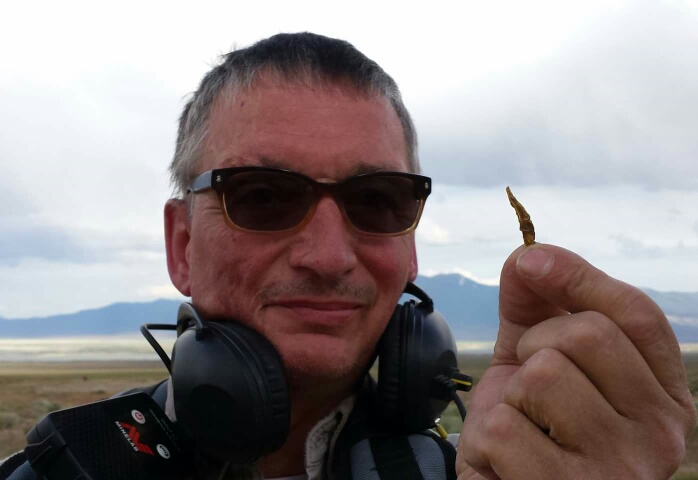
THANKS AGAIN GENTLEMAN. Till we meet again may we always scrub the ground with great coil control.
Kendall from
Wyoming
Good morning Gerry,
My name is Erik and I reside in Nevada. I have been prospecting for about 25 years and took up metal detecting about a year ago. Originally I purchased a mid range PI detector from Amazon. I had never received any formal training with the machine and detected on the weekends regularly for the majority of that year without any gold. On one of my later outings I performed a series of tests with my machine on a 1.5 pennyweight ( 2.3 gram) nugget buried at various depths. I realized that my machine was not “seeing” the target. Based on the recommendation of a fellow detectorist I contacted Gerry McMullen of Gerry’s Metal Detectors out of Boise, Idaho. Gerry was quick to respond and listen to my story. After listening, Gerry recommended the MineLab GPZ 7000 package and encouraged me to enroll in his training course to be held at Rye Patch, Nevada. Gerry gave me a great deal on the machine and training and the customer service was exceptional throughout the whole process of acquiring the machine and enrolling in training. At the three day training course, Gerry and his staff of expert metal detectors conveyed their knowledge on detecting techniques, detector types and capabilities, detector settings and operation, and target recognition and recovery techniques. Gerry and his staff were very professional and willing to share their wealth of knowledge on detecting and prospecting. The weekend following the training course, I found 4 nuggets at two different locations. One of the locations had been detected several times over by many different machines and operators.
All I can say is, If you are serious about finding gold, coins, or relics, buy the best from the best!
Thank you for helping me realize my goals in nugget shooting.
Erik L. in NV
I have been around this hobby for over 35 years and went from the guy that had no idea what ground balance or gain meant to where I am today. It has taken thousands of hours of research and time, putting good detecting habits into practice. I, myself, have been very fortunate to be around some of the best diggers that have ever held a metal detector in their hands. If anyone ever thinks they are the best and they can’t get any better or learn more about what we do, then they are sadly mistaken. To this day I continue to learn every time I turn on and start swinging. Being associated with these guys for the last several years has really given me an insight that very few people will ever have. The team of diggers I work with are some of the best and most successful group you will ever find. Our fearless leader keeps us up to date on new machines and technology to keep us at a level we have attained.
Now, how do you become the best detectorist you can be? First of all you must have an open mind and be willing to listen to the right people for instruction. In the past, I have been a involved in both Archery and Bowling to high degree. Those 2 sports taught me a very valuable lesson, if you want to be the best you can be, then learn from the best, someone that is very successful. I spent a lot of money buying the wrong stuff by listening to the “expert” that didn’t have a clue. I have learned how to do research from whom to seek advice. I run into people all the time that are wanting to get better, but they listen to people that have a good line but, don’t have the success to back up their claims.
It sometimes is hard to get rid of bad habits, whether it is in your swing or the way you do research. YouTube is nice and there are some good videos and knowledge to be found on the site. However, there is also a lot of wanting to be people giving some not so good advice. It’s important that you as a viewer know the difference. You ask how do I know, again look at what they have found. A few old coins or a couple of gold nuggets doesn’t mean they have the knowledge you seek. Another thing is don’t keep changing the settings on your machine because this guy says it is the best way to do it. Learn your machine from testing buried targets to find out what works to get the best results in your area. There are no magic setting, there is however very good setting to start and work with to get your best performance. You will never be good if you are always changing your detector from this guys or to the next video guy that knows it all. YOU must learn how your machine works and when you need to change settings. Learn the sounds, do not depend on the ID’S # on when to dig. They are for a reference point to what might be the target. It takes years of dedication to understand this hobby.
Now let’s talk about the detector that you have or want to get. I get asked all the time WHAT IS THE BEST MACHINE? The simple answer is “none” are the best at every task. And beyond that is what task are you wanting to use the detector. How about the selection of coils (not loops or heads) is compatible with a metal detector. What is the cost of the metal detector and the selection of coils you are going to need for your task? Not everyone can afford the most expensive detector on the market. But, if goal is to be the best nugget hunter you can be and are committed to that end, then, YES the Minelab GPZ-7000 is a machine you would definitely want to consider for Gold Nugget Hunting. To be honest, I am a bit prejudice about the brands of detectors I use so keep that in mind, but I use the one’s I use because they are the machines that I feel are the best for me and the tasks I want use them. That being said, here is what I have for my needs:
GPZ-7000
GPX-5000
CTX-3030
FISHER GOLD BUG-2
XP DEUS
These are not the only machines but they are my choice, do your research to find yours.
THIS IS MY OPINION: Yes, I put in thousands of hours swinging and learning and have found over a thousand gold nuggets and some nice coins and relics. Why did I pick those machines? It is simple for me. When it comes to finding Gold Nuggets, Minelab is unsurpassed for depth on larger nuggets. That is why I have the GPZ-7000 and the GPX- 5000. Those two machines are similar but not the same. There are times when the GPX-5000 will outshine the GPZ-7000 and so that is the one bring out of the truck. If you are hunting nuggets in an area that has had a lot of miners camping and leaving iron items and trash behind, then discrimination may be needed and the GPX-5000 is the detector I want to use. When hunting in the Nevada desert where ferrous items are limited and nuggets of all sizes are possible to be found then the GPZ-7000 is my first choice. I have owned all the Minelab series from the GP 3500 up to the GPZ-7000. The GP series detectors have been the best gold finding detectors of their time. I have been fortune enough to find enough gold to justify the investment and I believe if you have the proper tools to get the job done correctly your chances of success becomes greater. The Fisher Gold Bug-2 is designed to find smaller and shallower gold and I mean from fly *#*# to nice gold in the mineralized shallow ground. It is hard to beat the Gold Bug-2 when it comes to finding really small gold, but the Newer Minelab SDC-2300 comes very close but doesn’t have iron discrimination if that is needed. The last detector I use for hunting gold is the XP Deus. Now where would I use a multi purpose coin, relic and gold machine, in tailing piles looking for specimen gold. Again, these are my choices and for tailing piles The XP Deus is not the only detector that is good for the job, the Minelab X-terra 705 is the choice for a couple of the successful team members.
When it comes to coin and relic hunting the Minelab CTX-3030 is what I find works best for me. One of the reasons I like this machine because it is waterproof. If you choose to hit the lake or beach you don’t have to worry about getting it wet and it works outstanding in the water while jewelry hunting. It has a good selection of coils to cover your hunting needs. In high iron areas I use the 6 inch coil and if the area it is a more open and uncluttered spot with deep coins the 17 inch monster coil would be the choice. The Stock coil works great for all around detecting conditions. The CTX-3030 or Minelab’s SDC-2300 are some of the best in water looking for those platinum, gold and silver rings. Again, there are other choices, but the CTX has it all and it covers most all of my coil and relic hunting needs. The XP Deus however, is a good choice with very heavy iron where the coins are close to the ferrous objects. I have paid for the XP Deus in a couple spots, finding some very nice targets lying too close to iron that the CTX was unable to find. I always use both units when I am in an area where old goodies are coming out of the ground.
Back to how to become the best you can be. It takes hours and hours of using the correct techniques to become consistent in producing good finds. But just knowing your detector and technique is not enough by any means! The first part of becoming successful is doing the research to get you to a good spot. You can’t just always follow your buddies to get you to a good area. If they have been there, then you are looking for the left overs. It is fairly easy to find the cream in a spot, but to find what is below the cream and mixed in with the ferrous targets, or just plain DEEP TARGETS is what we are trying to do.
You must put in the time to be successful.
Wanting to find older coins and relics, then you have to be at a site that can hold those old items. The local city park is probably not your best choice but can be a very good place to practice honing your skills. The same holds true for a school yard. Lots of targets to get in some practice. With all the junk targets you can perfect your swing speed, coil control and keeping your coil level to the ground all the way through your swing. Learn how to separate targets and look for the deep ones, not the easy ones in the top 4 or 5 inches. Pass those up and leave those for later, but instead listen for the faint deep signals. The deep signals should be the better coins and relics. Look at the ground to see if has been turned over or fill has been added. While driving around look for old trees or stumps that have been there for years. Watch for older homes, especially ones that have bad lawn care. It can increase your chance to detect. Empty lots where old homes once stood. Look for foundations in those lots along with colored glass and trash from days gone by. Research at city hall or the library from where old roads or buildings once stood. Get photos from the era of when the community or mining camp was first started. Look at areas that didn’t have electricity back in the day, especially mine sites. Look for old maps of towns, forts or mining camps that are not on today’s maps.
The internet is a great source of information, but books and maps are usually the best way to go. As my detecting partner has told countless people, you will spend hundreds and even thousands of dollars buying that perfect detector, but you won’t spend a $100 a year buying research material to get you to those spots no one else finds. They are still out there. Research is all part of learning how to become successful.
Coils are always a hot topic. What coil do I need? Well, you need the one designed to do the task you are attempting. If you are looking for shallow small targets, then a huge coil is not a good choice. Same way if you are looking for deep targets a small coil is not correct choice. Are you going to use discrimination, if so, you will need a DD coil. If you are after depth and sensitivity the mono coil is what you will want because they are more sensitive than their DD partners. There is also concentric coils on our coin and relic machines. You need to match the right coil to the task at hand. Smaller coils are designed to find smaller shallow targets. Big coils are made to go deep looking for that Lunker or deep coin, but if there is a small target at depth the big coil will most likely not see it and the small coil can’t see that deep so what does that mean. You simply can’t get them all unless you are scraping off a few inches at a time down to bedrock but we do try. Again, do some testing, if you are a nugget hunter then buy yourself some lead (Bird shot and fishing weights) in different sizes and put them in the ground at different depths and TEST!!!
Coin hunters bury those coins in the ground so you can barely hear them. That serves two purposed, practice on faint targets and the opportunity to try different modes and setting to see what works in real life. Air tests are ok, but the mineralization and wetness in the ground tell the real story. That way you know what works and what doesn’t. That gives you the confidence and so you will not have to wonder if your machine and coil combination is correct. You will know! Confidence is a good thing. That is how we all have learned, practice practice practice….
You don’t have to be in the gold fields or a ghost town to become better on your detector. Instead of sitting on your couch go outside and put in some time learning about to make the machine and you work together to be successful. You might be surprised about how you want to get out there and find the get swinging after honing your skill level. If you have a family, what a way to spend some quality time together. And mom and dad you know the kids are going to get better than you.
In conclusion, you want to be really good or just so so, the choice is yours. Everyone doesn’t want to be a Pro but if you do, it requires time, energy, investment and a lot of hours swing an digging. Remember, if you want to be the best then learn what you can from the successful hunter. Detector classes give you a huge leap forward to becoming successful. The final word is something I did hear on a video from a fellow digger:
“Look of a reason to dig not for an excuse not to dig”
Thanks for your time,
Rye Patch Ron
PS: Always fill in your holes, ask permission and leave it as good or better than before you dug.
Our own “Scott” makes the CoilTek Ad..Congrats buddy!!
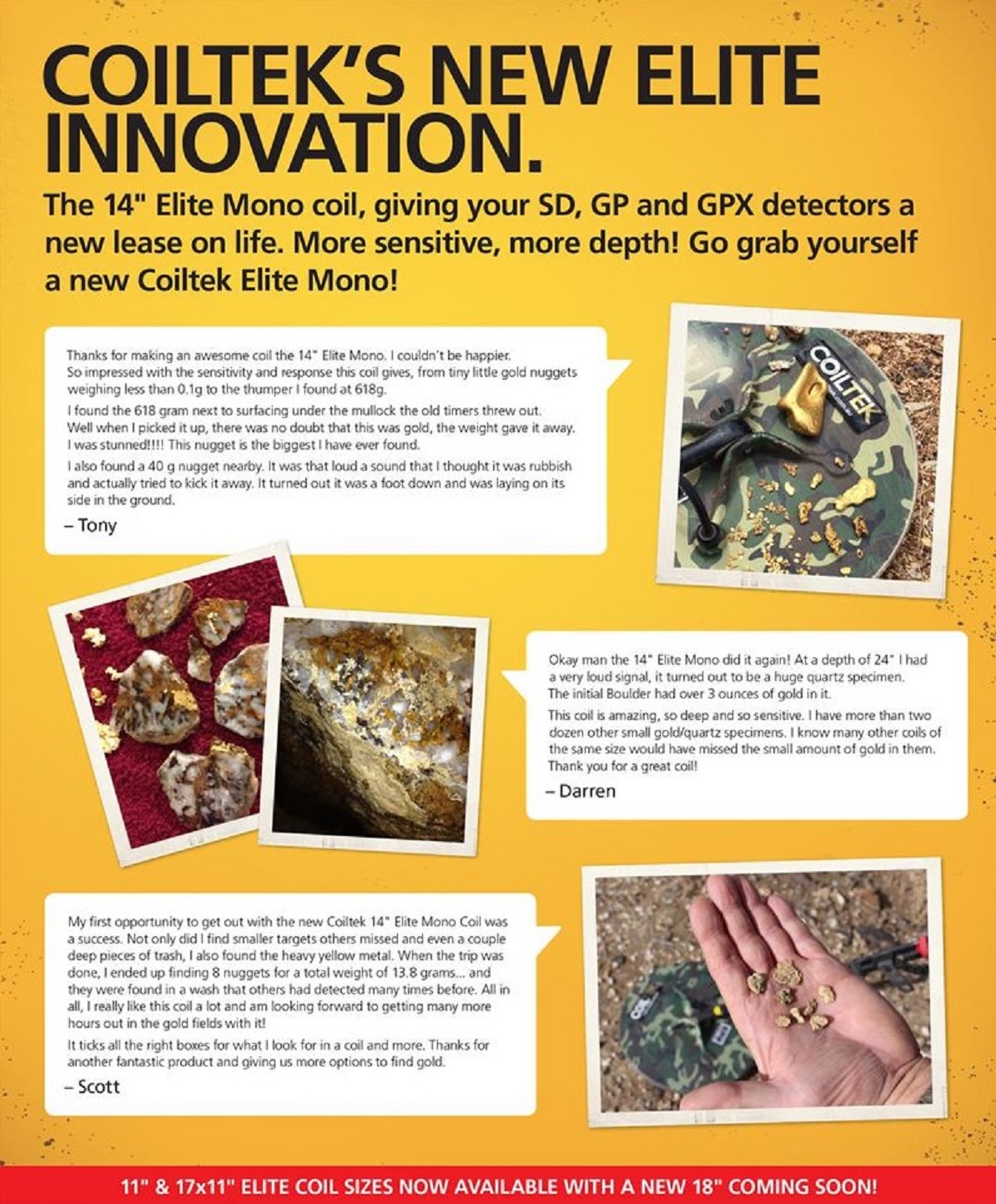
I was just looking at a friends post showing his CTX 3030 finds and thought I would share this. If you want to save the value of your investment here is what I purchased from Gerry McMullen to keep my 3030 in pristine condition. It comes with a WM protector and a display cover included. It is for the GPZ 7000 and it just a little big on the battery end but works just fine. Get a hold of https://gerrysdetectors.com/ to get yours.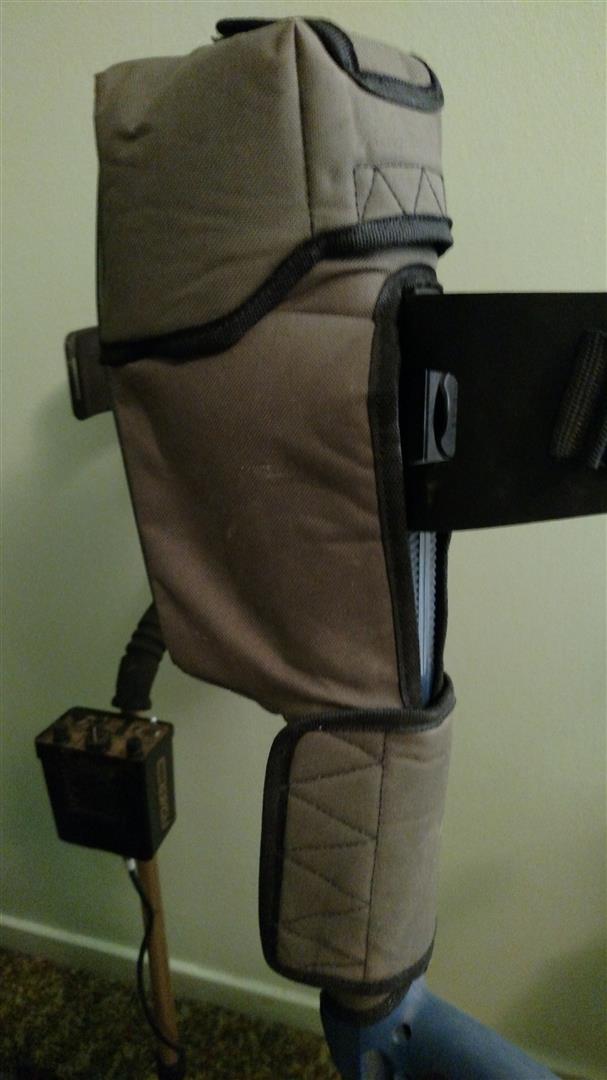
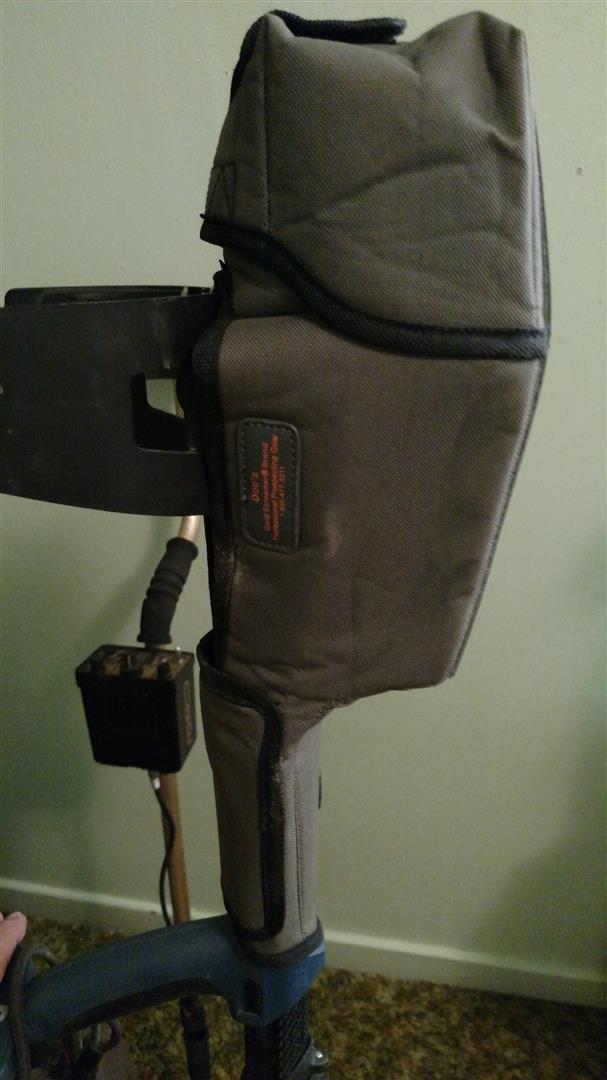
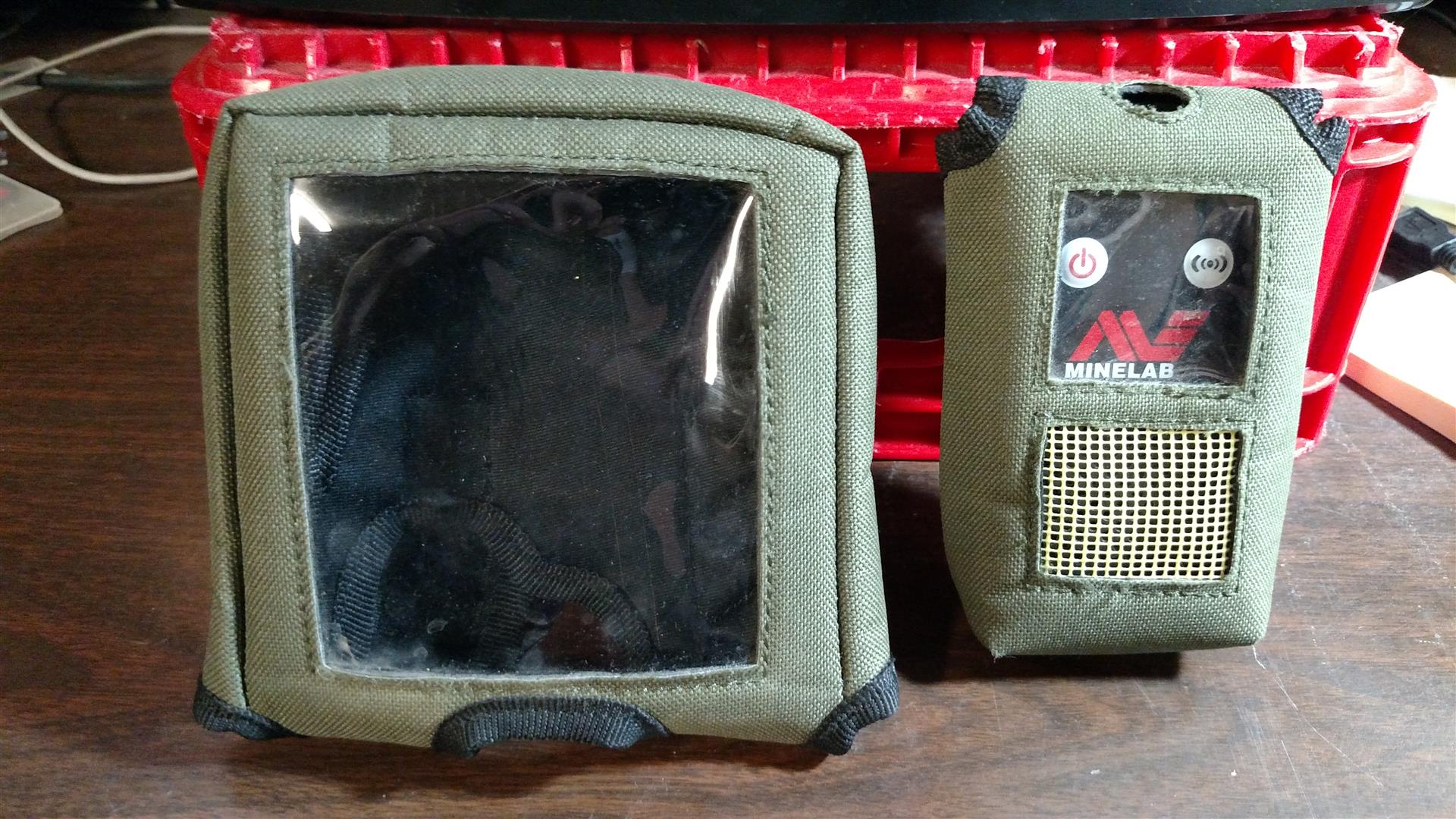
The New Coiltek 14" Round Elite Mono Coil Review by Staff Member Scott Thurber
November 23rd, 2015
Cody Holmes
Yes I did and I liked it…The first opportunity to get out with my Minelab GPX-5000 and the new CoilTek 14″ Mono Elite Coil was well worth the wait. Not only did I find smaller targets others missed and even a couple deep pieces of trash, I also found the heavy yellow metal. When the trip was done, I ended up finding 8 nuggets for a total weight of 13.8 grams….. and they were found in a wash that others had detected many times before.
Here are some of the 1st things I noticed and wanted to share.
Smooth, Stable & Quiet – I don’t worry about wearing out the coil covers, as I try to scrub my coils on the ground as much as possible to get best depth, this I learned a long time ago, that the farther the coil is off the ground, the less signal depth penetrating into the ground. This is not rocket science here folks! But another big benefit I noticed with this coil is how smooth and quiet it performed, even when bumping into rocks, bushes and such. It certainly runs much smoother than many of the older coils I have.
Sensitive to a variety of targets. I was also impressed with the sensitivity and signal response on the small targets, as well as bigger ones, even at depth! Little bits of trash (yes we find those too) were clean responsive signals, just like if using a smaller coil on a little nugget. I was quite impressed.
Depth to larger targets. I was excited to take this coil down to Rye Patch Nevada in order to test it on some targets that some of Gerry’s Detectors staff members have buried at known depths in years past. One target in particular is a 5 grammer at 24″ that was buried about three years ago. The 14″ Elite gave a soft clean signal that would grab your attention and cause you to stop and want to dig. Incredibly, I was able to raise the coil up off the ground a few more inches and still get a decent target response. Now that is impressive as I know some areas with deeper gold I plan on returning to.
Overall thoughts on a $400 investment of this coil. Considering I found 13.8 grams of gold with it in the short amount of time used, it certainly has paid for itself. But, the fact is even if I had not found the gold, I still could see, feel and hear the benefits of this new coil. If the opportunity arises, I like to try and one up my buddies and other hunters when we detect the same ground. To do so you need to take advantage of the new technologies and products by using it in your old sites before the others get there. CoilTek is a proven worldwide known brand and so I know (and proved it) a new coil will help me find more gold.
All in all, I really like this coil a lot and am looking forward to getting many more hours out in the gold fields with it!
This CoilTek 14″ Elite tics all the right boxes for what I look for in a coil and more.
Thanks for another fantastic product and giving us more options to find gold.
Scott Thurber
Carey Idaho USA
Here are some very nice finds from Gerry’s customers with the GPZ-7000. Raymond Stovall and his detecting partner ( Faus ) were previously trained on different gold machines, but this spring purchased 7000’s and went through training again. Congrats guys.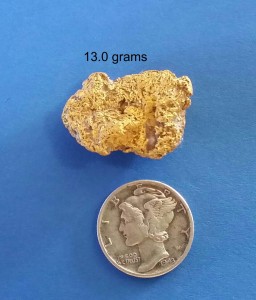
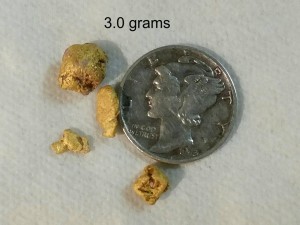
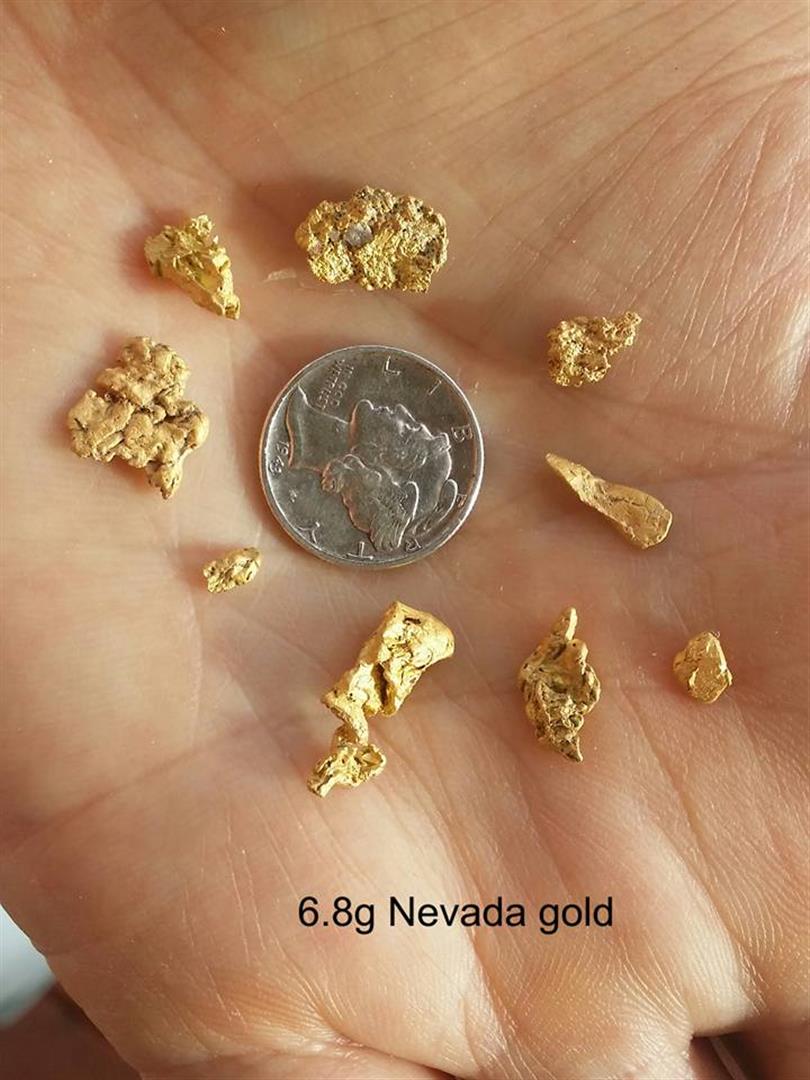
Hi Gerry,
I want to share with you my big find. I’m glad I took your training class at Rye Patch last May. I learned a lot and not to give up on a target. From the photos you can see I’ve done quite well with the SDC 2300. To the left in the photo, is gold I’ve found since May, plus below, what I found last Saturday, (some is pretty small ) and to the right the 4 nuggets that led me to the big one. I had a hit all around a boulder and was able to dig under one side and roll it. I still had the target but it was big. Hard packed gravel and I’m thinking a chunk of iron. I’m glad I stayed with it. Thank for your demonstrations of how gold and iron can sound the same.
Thanks again,
Dale

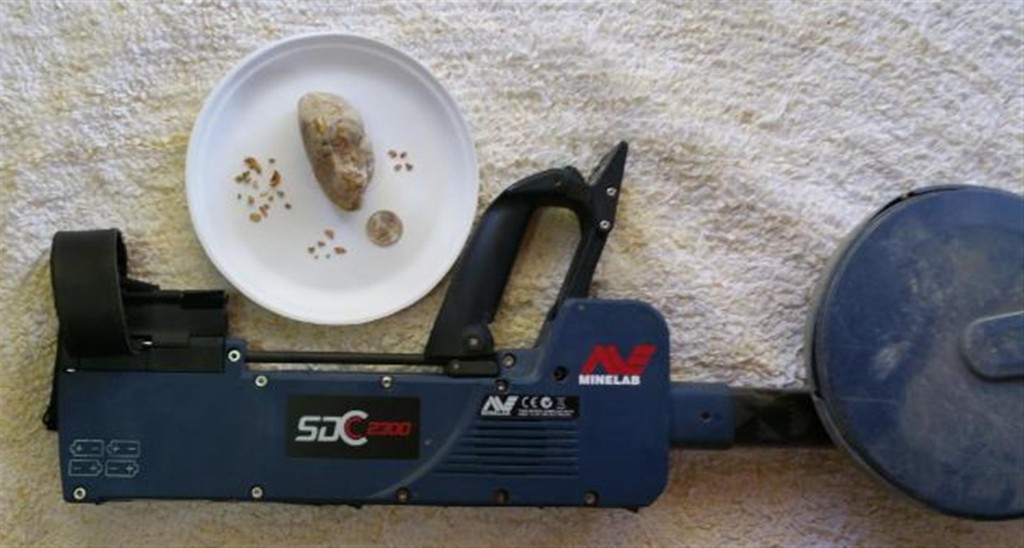
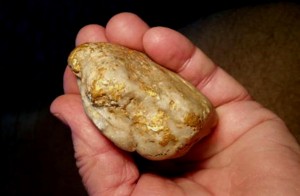
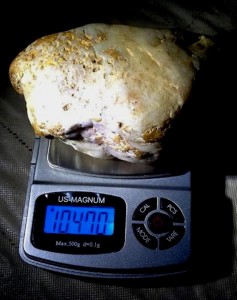
http://www.minelab.com/usa/treasure-talk/gpz-7000-ground-tracking-software-update
Use your xchange program and get the latest update for you GPZ-7000. It helps 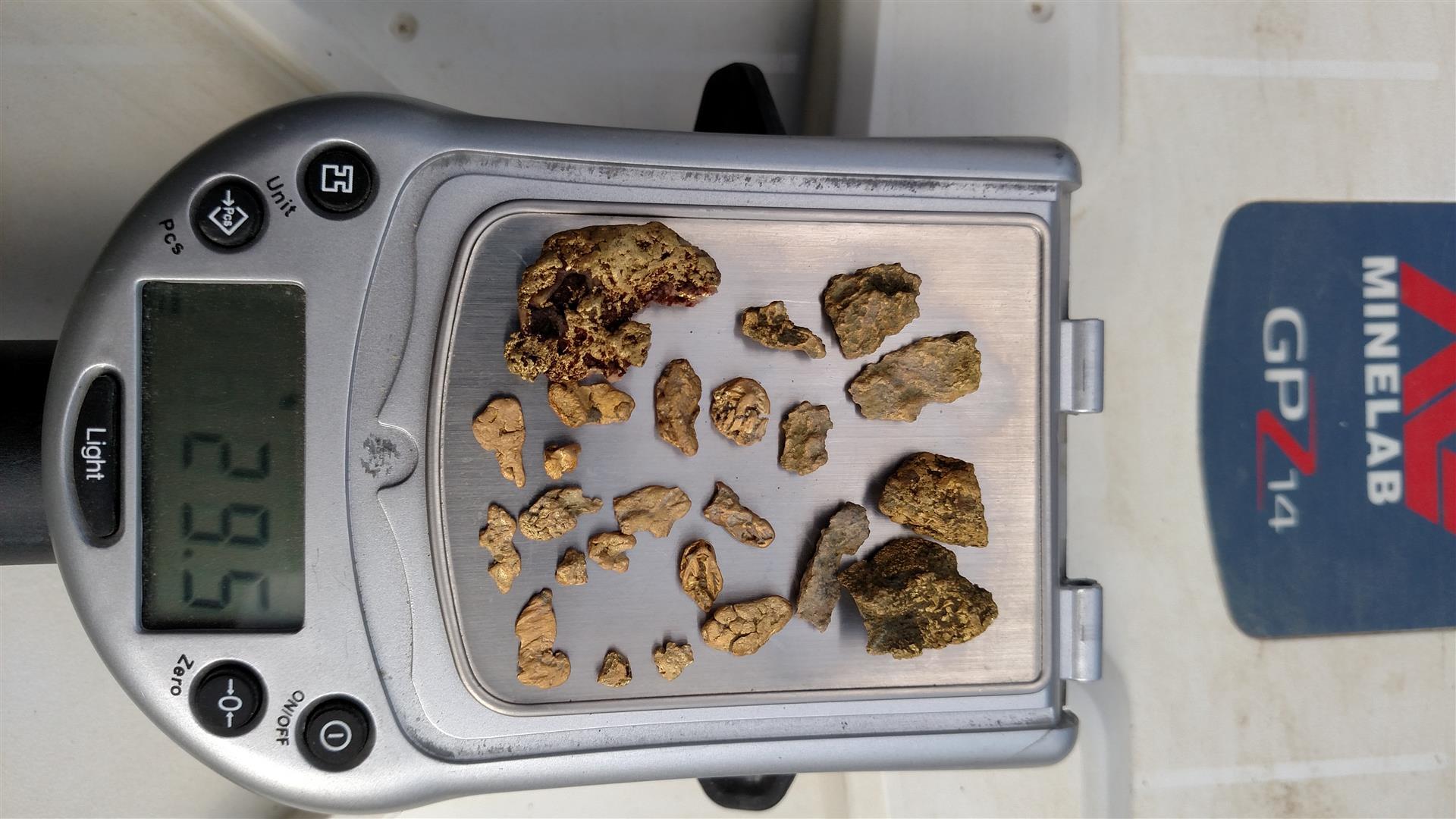
Gerry,
My first nugget, 1:45 hrs after I started swinging on my own.
Thanks for the settings! 
Further on this – “first nuggie”; not that the nuggie was huge by any measure, but this little guy was under a copper clad bullet fragment, and at only at 3 inches deep, or so.
I almost didn’t dig it…. I’m facing a partial knee replacement in another week+, so “digging everything” is not my first choice (it hurts to transition from down to up). Anyway, I double checked the target site, and there it was…. my first sub-gram piece with the GPZ-7000. All your lessons were heard and learned…. So, thanks again. We all may have missed the field exercises@ Sumpter, thanks to the fires, but our pre-field class – day 1, was huge in grounding us (well at least me,) and I’m sure the others also.
Thanks again for your efforts on these training programs that are tied to our purchases… It was a very important element in the “why” I choose to buy through you, and not thru those few others dealers that are making similar offerings:
The combined knowledge that you and your staff afford those of us who trying our best to put these operational “puzzles” together – to effectively utilize these ever evolving and relatively complex “tools” for finding the ever elusive “AU” (gold) in thoroughly pounded gold fields – well, it is the difference! The detector prices are the same between dealers, but you definitely offer the most important added-value, the knowledge base that helps make these new tools work, along with the rationale’s behind them.
Take care again, and I’ll still try to join you all at the next classes at RP this Fall (Oct or Nov), work permitting. I’ll let you know as soon as I know, if there’s any conflicts.
Best, Dave
More GPZ-7000 Gold.
We at Gerry’s Metal Detectors love to share photos of our customers success. Many times we get pictures that are nice, but folks use old cameras or just can’t seem to take a good shot. Anyway, don’t be offended, just share them, as we realize you would rather know how to use your detector and find gold, than how to take a photo and look at it.
1st picture is one of my California dudes & his gold found with Minelab GPZ-7000.
2nd shot is an Oregon customer’s 1st day out with his new GPZ-7000.
3rd photo gold found at Rye Patch, NV after my customer (from mid-west) took the class & then hunted for an extra couple days. (yes folks, you too can have a place to hunt after the 3 day class – provided you purchase your detector from us.)
4th is Idaho customer of mine & some of his recent gold nugget finds with GPZ.
CONTACT GERRY
Email: gerrys1det@cableone.net
Phone: (208) 345-8898
Gerry’s Metal Detectors
1101 N. 15th Street
Boise, ID 83702
(By appointment only)
I have been testing and comparing the GPZ –7000 since its conception. I have been working with Gerry and the other staff members so we get the most knowledge possible of what makes the 7000 the best gold finding metal detector on the market. The 7000’s new technology is not like anything we have seen before and so we all need to understand how to get the most out of us and the NEW GPZ.
The first thing you will notice about the 7000 is a new look. It looks similar to the CTX 3030 but that is where that comparison stops. I really like the collapsible lower shaft and the ergonomics of the new handle. Minelab choose to add a swing arm with the GPZ-7000 and at first being (I don’t need that type of guy) I left it off and went on my merry way. That did not last long. After the first hour I was back at the truck and adding it to the upper shaft of the GPZ. The swing arm really gives the operator very good coil control on flat ground and when swinging on a side hill is outstanding. The New style bungee cord works well and is easy to adjust on the fly, another very good improvement. The only complaint I had was the weight of new style coil, which has about 6000 feet of wire in its winding and it is a bit heavy, but that being said you will get used to it very quickly when you see the gold the 7000 is capable of finding. I was amazed at how the GPZ picked out small and deep nuggets in previously hunted out areas. I have only seen the Fishers Gold Bug 2 find pieces as small as the GPZ will find and at times the 7000 can find them deeper than the Gold Bug 2. The GPZ continues to find gold nuggets that ALL other detectors have missed. Minelab’s new technology is has been very impressive to the team members on Gerry’s Training Staff and his customers that we have trained.
What kinds of Gold will the Minelab’s New GPZ find? Well, almost all kinds. As some people know gold is just not found in solid nuggets. There is sponge , honey comb, specimen and of course the nice looking solid nugget to name a few. Some specimen gold is like salt and pepper just fine small bits of gold mixed with quartz and other minerals not always
visible to the naked eye. The 7000 did outstanding in our testing and finding in the field on these types of gold.
The GPZ’S new programing is easy to setup with the new screen showing you the options that are available for the user. Now I am not saying this is a turn on go metal detector because it is NOT. With all machines the user needs to understand the options on the unit and how they work. Gerry’s customers, that have had his training I believe will agree, getting hands on training is invaluable in learning your new gold nugget detector and what it can and can’t do. As an example when the ground is both mineralized and wet will the 7000 handle this condition? The simple answer is yes but there are trade offs from when the soil is in an ideal condition for detecting. Learning things like this from Gerry and his Training Staff will help you to be more successful with your new GPZ-7000 .
The new Menu now has the following options: Gold Mode & Ground Type
The Gold Mode function has three options: High Yield,General, Extra Deep.
The Ground Type has three options: Normal, Difficult, Severe.
This is a brief look at various combinations:
High Yield/Normal – For mild ground this is a good selection.
General/Normal – In mild to Medium soils, this will provide good depth on some sizes of gold
Extra Deep/Normal – The best depth combination for very large gold, but only in mild soils conditions
High Yield/Difficult – For finding the greatest number of targets in mineralized soils
General/Difficult – A good for setting for most medium to high mineralized ground. Runs smoother and provides a slight depth increase over High Yield on larger gold.
Extra Deep/Difficult – This is a specialty setting for maximum depth in mineralized soil and deep larger gold
Severe – Use this on the worst ground conditions, depth loss will occur using this setting.
In my opinion the GPZ-7000 is excellent new technology with great promise for the future. There is very little gold that can hide from this machine. I highly recommend the GPZ as the best gold finding metal detector that I have had in my hands in the 35 years! Get your NEW GPZ-7000 from https://gerrysdetectors.com/ and get Gerry’s Field Training to get you on the right track. Give Gerry a call or email him @ gerrys1det@cableone.net and start finding the gold you seek! You can follow Gerry on Facebook here: https://www.facebook.com/gerrysdetectors.
Watch Gerry’s videos here: https://www.youtube.com/watch?v=2Xt18yMvCnI
Rye Patch Ron’s personal site here:https://ryepatchronsmetaldetectingpage.wordpress.com/articlesreviews/
Email: gerrys1det@cableone.net
Phone: (208) 345-8898
Gerry’s Metal Detectors
1101 N. 15th Street
Boise, ID 83702
When one buys a new detector it takes time, patience and experience to get comfortable with your new machine. It helps if you buy your detector from Gerry at https://gerrysdetectors.com/ . Gerry will take the time to help you and does have one day classes for coin machine detectors. That being said after you are own your own and no one is standing there beside you telling you when to dig or how to adjust your machine life gets a little more difficult. When I started using the CTX 3030 I tried different settings and combinations of those settings. Now understand that no one’s settings will work in every situation. We have to learn when and what to change for the area you are hunting. EMI and wet soil can make a difference on a spot we are working. Say you are hunting under a power line next to the area, there is going to some interference. So you must remember to run your noise cancel (which I may do several times a day in that situation) to get your machine to run at it’s best. Setting the sensitivity to high or low will affect performance. You can run auto ground balance and not worry about that part but I do not unless all my targets are shallow and the ground is not mineralized. I am going to do a video on how I set up my machine in the near future but for now I will share my settings here. Now understand this is NOT the only way to run your machine it’s what I like and works for me. I do run a tone modified coin mode with the settings below. The tone settings are what I like they do not effect the depth.
Ron’s Program
Mode
Coin #
Pattern 2 All Metal
Audio Mode: Combined & Ferrous Coin
Response – Normal
Recovery Fast – Off ( run fast if you are in heavy iron but you will loose depth)
Recovery Deep – On
Seawater – Off
Target Separation – Ferrous Coin
PinPoint- Normal
Volume Gain – 30
Threshold Level – Just audible
Volume Limit – 20
Threshold Pitch – 15
Sensitivity set to manual. Start at 20-22 area and increase until your machine gets a little chatty then back it off 1 or 2 numbers. (Sometimes it will have to be less.)
Auto sensitivity Level– You can use Auto and if I do I run +3 but it does not go as deep most of the time but your machine will be somewhat more stable and give more consistent VDI #’s.
Ground Balance – Off
Noise Cancel – Auto
GPS – Off or on
Hope this helps some of you on your quest.
Ron
“I think I must have dropped it right in this area,” my friend Harry said as he pointed to a patch of ground that had been raked and detected for gold nuggets many times over the years. He was explaining to me that he had just searched the area extremely thoroughly with his Minelab GPX 5000 detector set in the fine gold timing with a small search coil, and had found a tiny nugget the size and shape of a very small bird shot. After showing it to a fellow prospector, Harry put the tiny bit of gold, along with his test nugget, back into his nugget bottle…or so he thought; upon showing his wife later that day, it was discovered that the tiny nugget was missing! The area was then scoured again with the GPX 5000, a Fisher Gold Bug Pro and a White’s GMT in search of the lost nugget, without success.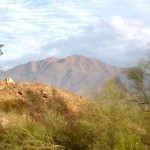
“Let me try to find it with my Minelab SDC 2300 detector, Harry,” I offered.
“Sure Lunk, that’s a great idea, go ahead!” He replied. So I quickly unfolded the unit, set it to maximum sensitivity and began slowly searching the area. Within just a couple of minutes, the 2300 responded with a crisp, clear signal. “I think I may have found it,” I said as Harry, his wife Maureen and a fellow prospector all huddled together in anticipation. After clearing the surface stones away from the underlying soil, I soon discovered that the target was actually buried. The target was out of the hole and in my scoop after removing only a couple inches of material. A quick sifting revealed a small, thin and ragged piece of gold. “Is this your nugget, Harry? I asked as I handed it to him.
“No, mine was shaped like a bird shot,” he replied as he handed me back the nugget, “but that’s impressive!”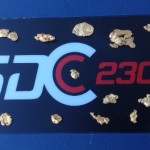
“Okay, well it’s gotta be in here somewhere,” I said as I continued the search. Soon I unearthed another small nugget, and another, neither of which were Harry’s missing nugget! Needless to say, everyone was incredulous that the SDC had so quickly found these targets that their detectors had missed. “It’s the new MPF technology of the SDC 2300 that is able to find nuggets that are just a little too deep for the very low frequency, VLF machines, and that don’t respond well or at all on other pulse-induction, PI detectors,” I explained.
Dusk was setting in over the Arizona desert by this time, so I resumed the search the following morning. After recovering seven more small nuggets with the 2300, none of which were Harry’s, I could only assume that his nugget had somehow escaped when he went to show it to his wife back at their RV.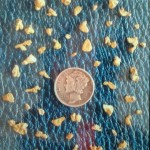
This is just one example of why I couldn’t put the Minelab SDC 2300 down from the time I picked one up in the middle of November until I started swinging the new Minelab GPZ 7000 in March. During that time the 2300 located over 155 nuggets, just on beat-up old patches. 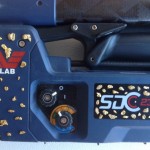 I haven’t had as much fun with any detector since I first started detecting for gold nuggets back in 1996, and I sure wish I would have had this magnificent machine back then. Happy prospecting!
I haven’t had as much fun with any detector since I first started detecting for gold nuggets back in 1996, and I sure wish I would have had this magnificent machine back then. Happy prospecting!
Travis out working with his SDC 2300 found a beautiful 1.23 oz. Idaho specimen gold nugget. The SDC 2300 is one of Minelab’s newest and hot gold finding machines. The 2300 finds both big and very small pieces of GOLD. Travis was trained on his new machine by Gerry’s Metal Detectors located Boise Idaho. The 2300 find nuggets that other machines have missed. Minelab’s new technology is a must have for the serious prospector.
